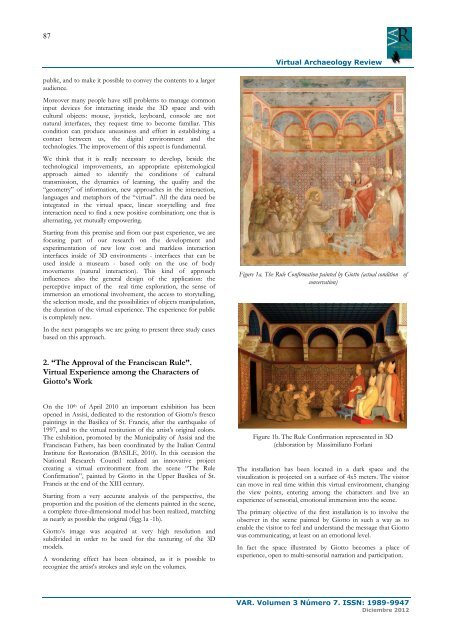Virtual Museums
Virtual Museums
Virtual Museums
You also want an ePaper? Increase the reach of your titles
YUMPU automatically turns print PDFs into web optimized ePapers that Google loves.
87<br />
public, and to make it possible to convey the contents to a larger<br />
audience.<br />
Moreover many people have still problems to manage common<br />
input devices for interacting inside the 3D space and with<br />
cultural objects: mouse, joystick, keyboard, console are not<br />
natural interfaces, they request time to become familiar. This<br />
condition can produce uneasiness and effort in establishing a<br />
contact between us, the digital environment and the<br />
technologies. The improvement of this aspect is fundamental.<br />
We think that it is really necessary to develop, beside the<br />
technological improvements, an appropriate epistemological<br />
approach aimed to identify the conditions of cultural<br />
transmission, the dynamics of learning, the quality and the<br />
“geometry” of information, new approaches in the interaction,<br />
languages and metaphors of the “virtual”. All the data need be<br />
integrated in the virtual space, linear storytelling and free<br />
interaction need to find a new positive combination; one that is<br />
alternating, yet mutually empowering.<br />
Starting from this premise and from our past experience, we are<br />
focusing part of our research on the development and<br />
experimentation of new low cost and markless interaction<br />
interfaces inside of 3D environments - interfaces that can be<br />
used inside a museum - based only on the use of body<br />
movements (natural interaction). This kind of approach<br />
influences also the general design of the application: the<br />
perceptive impact of the real time exploration, the sense of<br />
immersion an emotional involvement, the access to storytelling,<br />
the selection mode, and the possibilities of objects manipulation,<br />
the duration of the virtual experience. The experience for public<br />
is completely new.<br />
In the next paragraphs we are going to present three study cases<br />
based on this approach.<br />
2. “The Approval of the Franciscan Rule”.<br />
<strong>Virtual</strong> Experience among the Characters of<br />
Giotto’s Work<br />
On the 10 th of April 2010 an important exhibition has been<br />
opened in Assisi, dedicated to the restoration of Giotto's fresco<br />
paintings in the Basilica of St. Francis, after the earthquake of<br />
1997, and to the virtual restitution of the artist's original colors.<br />
The exhibition, promoted by the Municipality of Assisi and the<br />
Franciscan Fathers, has been coordinated by the Italian Central<br />
Institute for Restoration (BASILE, 2010). In this occasion the<br />
National Research Council realized an innovative project<br />
creating a virtual environment from the scene “The Rule<br />
Confirmation”, painted by Giotto in the Upper Basilica of St.<br />
Francis at the end of the XIII century.<br />
Starting from a very accurate analysis of the perspective, the<br />
proportion and the position of the elements painted in the scene,<br />
a complete three-dimensional model has been realized, matching<br />
as nearly as possible the original (figg.1a -1b).<br />
Giotto’s image was acquired at very high resolution and<br />
subdivided in order to be used for the texturing of the 3D<br />
models.<br />
A wondering effect has been obtained, as it is possible to<br />
recognize the artist's strokes and style on the volumes.<br />
<strong>Virtual</strong> Archaeology Review<br />
Figure 1a. The Rule Confirmation painted by Giotto (actual condition of<br />
conservation)<br />
Figure 1b. The Rule Confirmation represented in 3D<br />
(elaboration by Massimiliano Forlani<br />
The installation has been located in a dark space and the<br />
visualization is projected on a surface of 4x5 meters. The visitor<br />
can move in real time within this virtual environment, changing<br />
the view points, entering among the characters and live an<br />
experience of sensorial, emotional immersion into the scene.<br />
The primary objective of the first installation is to involve the<br />
observer in the scene painted by Giotto in such a way as to<br />
enable the visitor to feel and understand the message that Giotto<br />
was communicating, at least on an emotional level.<br />
In fact the space illustrated by Giotto becomes a place of<br />
experience, open to multi-sensorial narration and participation.<br />
VAR. Volumen 3 Número 7. ISSN: 1989-9947<br />
Diciembre 2012


